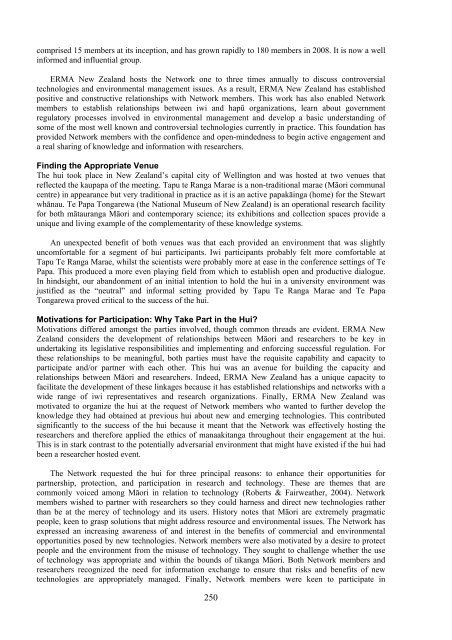traditional knowledge conference 2008 te tatau pounamu
traditional knowledge conference 2008 te tatau pounamu
traditional knowledge conference 2008 te tatau pounamu
Create successful ePaper yourself
Turn your PDF publications into a flip-book with our unique Google optimized e-Paper software.
comprised 15 members at its inception, and has grown rapidly to 180 members in <strong>2008</strong>. It is now a wellinformed and influential group.ERMA New Zealand hosts the Network one to three times annually to discuss controversial<strong>te</strong>chnologies and environmental management issues. As a result, ERMA New Zealand has establishedpositive and constructive relationships with Network members. This work has also enabled Networkmembers to establish relationships between iwi and hapū organizations, learn about governmentregulatory processes involved in environmental management and develop a basic understanding ofsome of the most well known and controversial <strong>te</strong>chnologies currently in practice. This foundation hasprovided Network members with the confidence and open-mindedness to begin active engagement anda real sharing of <strong>knowledge</strong> and information with researchers.Finding the Appropria<strong>te</strong> VenueThe hui took place in New Zealand’s capital city of Wellington and was hos<strong>te</strong>d at two venues thatreflec<strong>te</strong>d the kaupapa of the meeting. Tapu <strong>te</strong> Ranga Marae is a non-<strong>traditional</strong> marae (Māori communalcentre) in appearance but very <strong>traditional</strong> in practice as it is an active papakāinga (home) for the S<strong>te</strong>wartwhānau. Te Papa Tongarewa (the National Museum of New Zealand) is an operational research facilityfor both mātauranga Māori and con<strong>te</strong>mporary science; its exhibitions and collection spaces provide aunique and living example of the complementarity of these <strong>knowledge</strong> sys<strong>te</strong>ms.An unexpec<strong>te</strong>d benefit of both venues was that each provided an environment that was slightlyuncomfortable for a segment of hui participants. Iwi participants probably felt more comfortable atTapu Te Ranga Marae, whilst the scientists were probably more at ease in the <strong>conference</strong> settings of TePapa. This produced a more even playing field from which to establish open and productive dialogue.In hindsight, our abandonment of an initial in<strong>te</strong>ntion to hold the hui in a university environment wasjustified as the “neutral” and informal setting provided by Tapu Te Ranga Marae and Te PapaTongarewa proved critical to the success of the hui.Motivations for Participation: Why Take Part in the Hui?Motivations differed amongst the parties involved, though common threads are evident. ERMA NewZealand considers the development of relationships between Māori and researchers to be key inundertaking its legislative responsibilities and implementing and enforcing successful regulation. Forthese relationships to be meaningful, both parties must have the requisi<strong>te</strong> capability and capacity toparticipa<strong>te</strong> and/or partner with each other. This hui was an avenue for building the capacity andrelationships between Māori and researchers. Indeed, ERMA New Zealand has a unique capacity tofacilita<strong>te</strong> the development of these linkages because it has established relationships and networks with awide range of iwi representatives and research organizations. Finally, ERMA New Zealand wasmotiva<strong>te</strong>d to organize the hui at the request of Network members who wan<strong>te</strong>d to further develop the<strong>knowledge</strong> they had obtained at previous hui about new and emerging <strong>te</strong>chnologies. This contribu<strong>te</strong>dsignificantly to the success of the hui because it meant that the Network was effectively hosting theresearchers and therefore applied the ethics of manaakitanga throughout their engagement at the hui.This is in stark contrast to the po<strong>te</strong>ntially adversarial environment that might have exis<strong>te</strong>d if the hui hadbeen a researcher hos<strong>te</strong>d event.The Network reques<strong>te</strong>d the hui for three principal reasons: to enhance their opportunities forpartnership, pro<strong>te</strong>ction, and participation in research and <strong>te</strong>chnology. These are themes that arecommonly voiced among Māori in relation to <strong>te</strong>chnology (Roberts & Fairweather, 2004). Networkmembers wished to partner with researchers so they could harness and direct new <strong>te</strong>chnologies ratherthan be at the mercy of <strong>te</strong>chnology and its users. History no<strong>te</strong>s that Māori are extremely pragmaticpeople, keen to grasp solutions that might address resource and environmental issues. The Network hasexpressed an increasing awareness of and in<strong>te</strong>rest in the benefits of commercial and environmentalopportunities posed by new <strong>te</strong>chnologies. Network members were also motiva<strong>te</strong>d by a desire to pro<strong>te</strong>ctpeople and the environment from the misuse of <strong>te</strong>chnology. They sought to challenge whether the useof <strong>te</strong>chnology was appropria<strong>te</strong> and within the bounds of tikanga Māori. Both Network members andresearchers recognized the need for information exchange to ensure that risks and benefits of new<strong>te</strong>chnologies are appropria<strong>te</strong>ly managed. Finally, Network members were keen to participa<strong>te</strong> in250
















